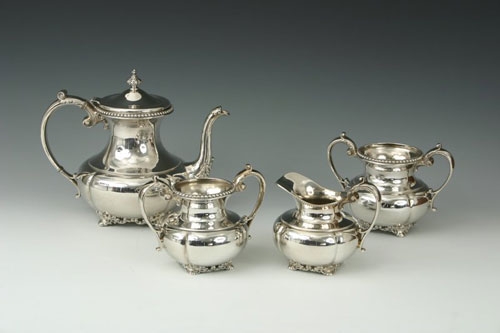American’s manufacturing history in silver, pewter, Britannia and electroplated wares coincides with the rise of the Industrial revolution and methods of mass production. Centred in New England, places such as Meriden and Wallingford, Connecticut became as famous to a world of wholesalers and retailers as Birmingham, England.
Silver & Metalware: American Silver Plate Tea Set 1896-1904
In 1810, the single silver-smith could still be found in local advertisements. Commissions in hand wrought items were directed to the wealthy and elite. By 1910, huge conglomerates made up of partnerships and previously independent companies existed to make silver and silver plate available to everyone.
The desire to adorn ones home and table with the look of solid silver (without the expense) was present in the 18th century. In 1742, and Englishman named Thomas Boulshover accidentally fused silver to copper while trying to mend a knife blade. Manufacturers in Sheffield took over the method of heating thin sheets of silver, front and back, to thicker center cores of copper. These fused “sheets” could be rolled out and formed into fancy hollow ware trays, urns, candelabrum, etc. Sterling was decoratively applied to the exposed copper edges. These “old Sheffield” pieces satisfied the emerging middle classes in England and America for nearly a hundred years, and are sought after by today’s collectors.
Electroplating was invented by John Wright, a medical student, and also an Englishman. The first patent was issued to G.R. and H. Elkington in 1840. Oxide of silver was dissolved in a bath of cyanide of potassium and reformed onto the surface of copper or other base metals with the use of a galvanic current.
John O. Mead, a Britannia manufacturer from Philadelphia helped perfect the electroplating process in America. His association with pioneering Rogers brothers is not officially documented, but there is a connection.
The Rogers name spans the rest of the 19th century. William, the eldest brother, left the family farm and became a partner with Joseph Church (jeweler and silversmith in Hartford, Conn.) in 1825. By 1835, Asa Jr. and Simeon had both joined the firm. Asa Jr. started experimenting with electroplating in the early 1840’s. In 1847, the first Rogers Brothers trademark was stamped on their silver plate spoons. The Rogers name became so important in the business that many affiliations would form companies to use the Rogers name. Some were related by family ties and some just lucky enough to have the same name. The F.B. Rogers Silver Co. was incorporated in 1886, in Taunton Massachusetts. This company worked well into the 20th century, and became a division of the National Silver Company in 1955.
In 1862, the Meriden Britannia Company purchased the Rogers Brothers Manufacturing Company, including their tools, dies and trademark. Many other small companies in the area realized the benefits of banding together to better supply the growing public demand. The International Silver Company was incorporated in 1898. Along with the 1847 Rogers Bros. trademark, the Meriden Britannia Company led the way. Soon, over forty firms would join, often retaining their own trademarks under the I.S. Co. umbrella. Some of these names include the American Silver Co., Barbour Silver Co., Forbes Silver Co., Holmes & Edwards Silver Co., Manhattan Silver Plate Co., Meriden Silver Plate Co., Simpson, Hall, Miller & Co., C. Rogers & Bros., Rogers & Hamilton Co., Rogers, Smith & Co., Watrous Mfg. Co., Webster Mfg. Co., Wilcox Silver Plate Co, Wilcox & Everster, and the William Rogers Mfg. Co.
The International Silver Co. reached its height in production by the World War II years.











